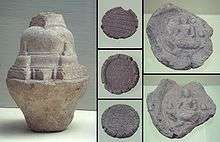Stupika

Shaiva temple with stupika finials at the roof corners. 8th century,
from Gedong Songo II in central Java.
A stupika is a small votive stupa. It is often accompanied by small votive tablets with Buddhist formulae, or small Buddhist images.[1] The stupika can also be the topmost part of a building, particularly a Hindu temple.[2]
References
- ↑ Miksic, John N. (2003). Earthenware in Southeast Asia. NUS Press. p. 289. ISBN 978-9971-69-271-1. Retrieved 2009-08-16.
- ↑ Snodgrass, Adrian (1985). The Symbolism of the Stupa. SEAP Publications. p. 263. ISBN 978-0-87727-700-2. Retrieved 2009-08-16.
This article is issued from
Wikipedia.
The text is licensed under Creative Commons - Attribution - Sharealike.
Additional terms may apply for the media files.
